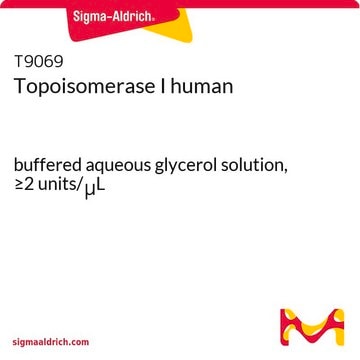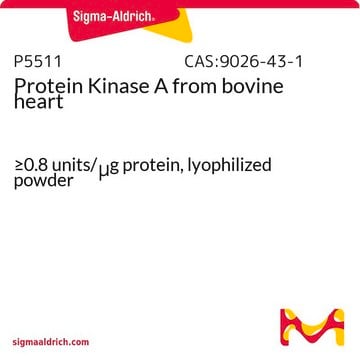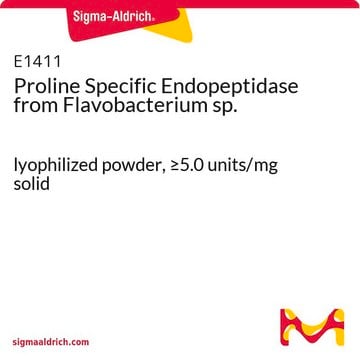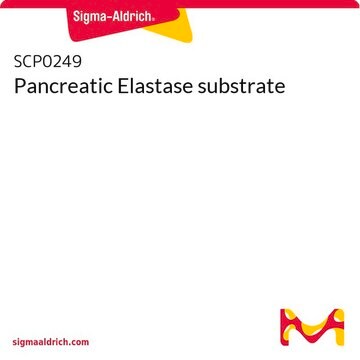This form of neutrophil elastase is a salt-free preparation and is supplied in an active form with a specific activity of ≥20 units/mg protein. It is not sterile and has not been tested for cell culture applications. To use it in a cell culture assay, sterile filtration is necessary, which may result in some product retention on the filter.
推荐产品
质量水平
描述
Merck USA index - 14, 3535
表单
lyophilized solid
比活
≥20 units/mg protein
制造商/商品名称
Calbiochem®
储存条件
OK to freeze
运输
ambient
储存温度
−20°C
一般描述
警告
单位定义
外形
制备说明
重悬
分析说明
其他说明
Junger, W.G., et al. 1992.Biol. Chem. Hoppe-Seyler 373, 691.
Selak, M.A. 1992.Thromb.Haemost.68, 570.
Baugh, R.J., and Travis, J. 1976.Biochemistry15, 836.
法律信息
警示用语:
Danger
危险分类
Eye Irrit. 2 - Resp. Sens. 1 - Skin Irrit. 2 - STOT SE 3
靶器官
Respiratory system
储存分类代码
11 - Combustible Solids
WGK
WGK 3
闪点(°F)
Not applicable
闪点(°C)
Not applicable
-
Hi Is this form of neutrophil elastase active and suitable be used directly in a cell assay? And is it sterile ? Mvh Magdalena
1 answer-
Helpful?
-
-
Has this product been tested for the presence of endotoxin?
1 answer-
Unfortunately, this product has not been tested for the presence for endotoxins
Helpful?
-
-
what is the molecular wight of the enzyme ?
1 answer-
Unfortunately, the molecular weight has not been determined for this product. A number of estimates have been reported in the literature. Please see the link below to a publication that may be helpful:
https://www.sciencedirect.com/science/article/pii/S1016847823175091?via%3DihubHelpful?
-
-
Is this the active form of the enzyme? or does it require activation by cathepsin?
1 answer-
Here are the recommended reconstitution and reaction conditions:
Solubility information:
Reconstitute in 50 mM sodium acetate, pH 5.5, with 200 mM NaCl or in other aqueous buffers. Material is most active near a neutral pH, but to maintain stability upon reconstitution, use in a slightly acidic buffer (pH 5.5) to avoid autolysis.
Following reconstitution, aliquot and freeze (-20°C) for long term storage or refrigerate (4°C) for short-term storage. Acidic stock solutions are stable for up to 1 month at 4°C or for up to 1 year at -20°C.Human Neutrophil Elastase Protocol
1. Dissolve enzyme in reaction buffer: 100 mM Tris-HCl, pH 7.5, 500 mM NaCl.
2. Prepare the substrate stock solution by dissolving Elastase Substrate I (MeOSuc-Ala-Ala-Pro-Val-pNA, Cat. No. 324696) at 50 mM in DMSO.
3. Just prior to assay, dilute the substrate stock solution with an equal volume of 200 mM Tris-HCl, pH 8.0. Mix well.
4. Prepare the assay mixture by combining 960 µl of reaction buffer with 40 µl of diluted substrate stock solution.
5. Add enzyme to assay mixture, mix, and incubate at 25°C.
6. Monitor the change in absorbance at 410 nm. Use an ε of 8800 at 410 nm to calculate the hydrolysis of nitroanilide.Helpful?
-
Active Filters
我们的科学家团队拥有各种研究领域经验,包括生命科学、材料科学、化学合成、色谱、分析及许多其他领域.
联系技术服务部门










